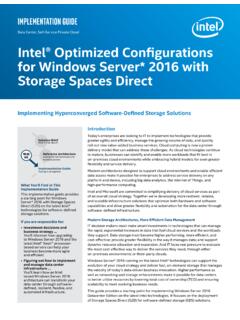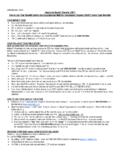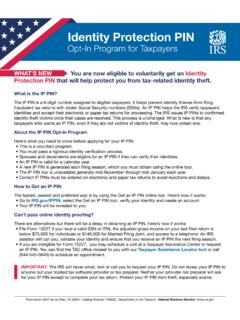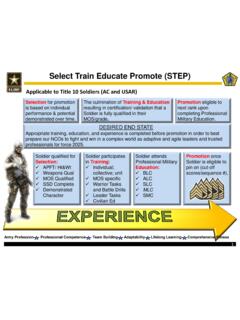Transcription of CPU Pin and Isolation in Kubernetes App ... - Intel® Builders
1 1 TECHNOLOGY GUIDE Intel Corporation CPU Management - CPU Pinning and Isolation in Kubernetes * Technology Guide Authors Philip Brownlow Dave Cremins 1 Introduction This document discusses the CPU pinning and Isolation capability, which enables efficient and deterministic workload utilization of the available CPUs. Kubernetes * (K8s*) supports CPU and memory as first-class resources. Intel has created CPU Manager for Kubernetes * (also called CMK), an open-source project that enables additional CPU utilization optimization capabilities for K8s* and simplifies their deployment. This document details the setup and installation of CPU Manager for Kubernetes *, set up of power management capabilities and processes for Isolation , and associated performance benchmark results.
2 The document is written for developers and architects who want to integrate the new technologies into their Kubernetes *-based networking solutions. This feature can be utilized along with the other Kubernetes capabilities in order to achieve improved network I/O, deterministic compute performance, and server platform sharing benefits offered by Intel Xeon Processor-based platforms. CPU pinning and Isolation is part of a set of tools developed to enable platform capabilities discovery, intelligent configuration and workload-placement decisions resulting in improved and deterministic application performance. Note: For more setup and installation guidelines of a complete system, refer to the Deploying Kubernetes * and Container Bare Metal Platform for Network Functions Virtualization (NFV) Use Cases with Intel Xeon Scalable Processors User Guide listed in Table 2.
3 This document is part of the Container Experience Kit. Container Experience Kits are a collection of user guides, application notes, feature briefs, and other collateral that provide a library of best-practice documents for engineers who are developing container-based applications and can be found at: Technology Guide | CPU Management - CPU Pinning and Isolation in Kubernetes * 2 Table of Contents 1 Introduction .. 1 Intended Audience .. 3 Terminology .. 4 Reference Documentation .. 4 2 Overview .. 5 CPU Manager for Kubernetes * .. 5 CPU Manager (in native K8s) .. 6 Technology Comparison .. 8 3 Deployment .. 9 CPU Manager for Kubernetes * .. 9 Installation .. 10 CPU Manager for Kubernetes * Commands.
4 11 Init .. 11 Install .. 11 11 Reconcile .. 11 Node-Report .. 11 Webhook .. 12 Isolate .. 12 Describe .. 12 Cluster-Init .. 12 Uninstall .. 12 Reconfigure_setup .. 12 Reconfigure .. 12 Reaffinitize .. 13 Dynamic Pool Reconfiguration .. 13 Exclusive-non-isolcpus Pool .. 14 Installation .. 15 Example Usage .. 16 4 Implementation Example .. 16 5 Power Management Capabilities using CPU Manager for Kubernetes * .. 16 Base Frequency .. 16 Core Power .. 16 6 Testing .. 18 Test Setup .. 18 DPDK testpmd .. 18 Qperf (L3 Workload) .. 18 Test Results .. 19 DPDK testpmd Performance with and without CPU Manager for Kubernetes * .. 19 Qperf Transmission Control Protocol (TCP) Performance with and without CPU Manager for Kubernetes *.
5 21 7 Summary .. 22 Performance Test Configuration .. 23 Hardware Configuration .. 23 Software Configuration .. 23 Figures Figure 1. Initial CPU Manager for Kubernetes * Pool Configuration .. 6 Figure 2. CPU Manager for Kubernetes * Pools with Deployment .. 6 Figure 3. CPU Manager for Kubernetes * Pools: reserved-cpus Flag Set to 0,1,8,9 with No Created Pods .. 7 Figure 4. CPU Manager for Kubernetes * Pools with Requested Pods .. 8 Figure 5. Deployment Diagram .. 10 Figure 6. CPU Manager for Kubernetes * Pools Dynamic Pool Reconfiguration .. 13 Figure 7. Initial CPU Manager for Kubernetes * Pool Configuration with Additional Pool .. 14 Figure 8. CPU Manager for Kubernetes * Pools with Deployment and Additional Pool.
6 15 Figure 9. High-Level Overview of DPDK Testpmd Workload Setup .. 18 Figure 10. High-Level Overview of qperf Server Workload Setup .. 19 Figure 11. DPDK Testpmd Throughput (higher throughput is better) .. 20 Technology Guide | CPU Management - CPU Pinning and Isolation in Kubernetes * 3 Figure 12. DPDK Testpmd Latency (lower latency is better) .. 20 Figure 13. Qperf TCP Throughput with Noisy Neighbor Comparison (higher throughput is better) .. 21 Figure 14. Qperf TCP Latency with Noisy Neighbor comparison (lower latency is better) .. 21 Tables Table 1. Terminology .. 4 Table 2. Reference Documents .. 4 Table 3. Technology Comparison .. 8 Table 4. Scenario 1 Example Configuration .. 17 Table 5. Scenario 2 Example Configuration, Cores and EPP Values.
7 17 Table 6. Scenario 2 Example Configuration, Pool and Cores .. 17 Table 7. Hardware Components for Performance Benchmark Tests .. 23 Table 8. Software Components for Performance Benchmark Tests .. 23 Document Revision History REVISION DATE DESCRIPTION 001 December 2018 Initial release of document. 002 April 2020 Added power management capabilities. Added support for exclusive-non-isolcpus pool. 003 January 2021 Added dynamic reconfiguration commands to section Added separate dynamic reconfiguration section as Both describe an overview of what the functionality accomplishes and how it is utilized. Intended Audience CPU Manager for Kubernetes * provides basic core affinity for NFV-style workloads on top of K8s. This document is intended for communication service providers who are planning and deploying virtualized mobile core infrastructure running on the latest Intel Xeon Scalable Processors.
8 Technology Guide | CPU Management - CPU Pinning and Isolation in Kubernetes * 4 Terminology Table 1. Terminology TERM DESCRIPTION CMK CPU Manager for Kubernetes * CPU Central Processing Unit CRD Custom Resource Definition DPDK Data Plane Development Kit EPA Enhanced Platform Awareness EPP Energy Performance Preference. The value that associates a core with a priority level when using Intel SST-CP. Exclusive CPU An entire physical core dedicated exclusively to the requesting container, which means no other container will have access to the core. Assigned by the exclusive pool within CPU Manager for Kubernetes *. Exclusive pool A group of isolated, exclusive CPUs where a container will be exclusively allocated requested number of CPUs, meaning only that container can run on that CPU.
9 Intel HT Intel Hyper-Threading. I/O Input / Output JSON* JavaScript Object Notation Kubernetes * K8s* NFV Network Functions Virtualization PMD Poll Mode Driver Pool CPU Manager for Kubernetes * uses a Kubernetes * config-map to represent the cores available on the system. The items in this config-map are defined as pools. A pool, in this context, is a named group of CPU lists. QoS Quality of Service RCU Read Copy Update Shared pool A group of isolated, shared CPUs where a requesting container can run on any CPU in this pool with no guaranteed exclusivity. Slot An exclusive CPU in the exclusive pool SR-IOV Single-Root Input/Output Virtualization SST-BF Intel Speed select Technology Base Frequency SST-CP Intel Speed select Technology Core Power SKU Stock Keeping Unit TCP Transmission Control Protocol UDP User Datagram Protocol VF Virtual Function Webhook server CMK deploys a mutating admission webhook server, which adds required details to a pod requesting its use.
10 Reference Documentation Table 2. Reference Documents REFERENCE SOURCE Enhanced Platform Awareness in Kubernetes * Feature Brief Enhanced Platform Awareness in Kubernetes * Application Note Enabling New Features with Kubernetes * for NFV White Paper Enhanced Platform Awareness in Kubernetes * Performance Benchmark Report CPU Manager for Kubernetes * repository Technology Guide | CPU Management - CPU Pinning and Isolation in Kubernetes * 5 REFERENCE SOURCE Intel Speed select Technology - Base Frequency (Intel SST-BF) with Kubernetes * Application Note 2 Overview Under normal circumstances, the kernel task scheduler treats all CPUs as available for scheduling process threads and preempts executing process threads from giving CPU time to other applications.










